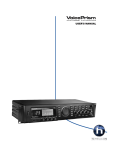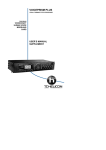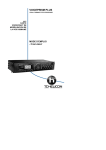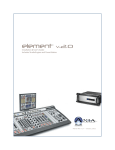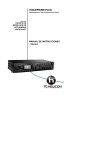Download VoicePrism Quick Start Guide - TC
Transcript
VoicePrism QuickStart Manual QuickStart: Setup and Level Setting QUICKSTART We know you want to start using your new VoicePrism, so we put the essentials here for a fast start. Once you’ve satisfied your initial needs for instant gratification, it is a good idea to skim through the rest of the manual to learn about advanced setup configurations, audio utilities, preset modifications, effects selections, and so much more... and most of the green LED’s are illuminated. The bar of LED’s beside the numerical display show the relative headroom, so you can get an idea of when clipping will occur. Ideally, the yellow LED should rarely light. The top red OvF LED should never light. 8. Slowly increase the LEAD level until you can hear yourself singing though the speakers. 9. Press the HARMONY button to turn on the harmony voices. 10. Press the SHIFT browser button (this selects presets that produce simple pitch-shifting). 11. Slowly increase the HARMONY level until you can hear the shifted voices through your speakers. Note: If you are using the Line Input (or Aux In), and are reading low levels but still getting distortion, check that the In Gain switch on the back panel is set correctly to be either +4dBu or -10dBV, depending on your input source. Quick Setup: We assume that you have a mixer/amplifier and speakers, a MIDI keyboard and sufficient cabling, and the expertise to have everything hooked together and working with VoicePrism. 1. Make sure the power switch is off before making any connections. 2. Plug your microphone into the front panel mic in. 3. Connect the audio out to your mixer. Use the left channel output for a mono signal. 4. Connect the MIDI output of your keyboard to VoicePrism’s MIDI IN. Making Some Noise: Level Setting: Refer to the front panel diagram, page 4. 1. Set LEAD, HARMONY, EFFECTS level knobs and INPUT knob off (counterclockwise). 2. Turn the headphone LEVEL off. 3. Turn VoicePrism on first, then your connected equipment. 4. Select Preset #1. 5. Press the HARMONY button (light is off) to put VoicePrism in lead voice only mode. 6. Press the MIC ON button (light is on). For condenser mics needing phantom power also press the 48V button (light is on). 7. Slowly increase the INPUT knob setting while singing until the LOCK LED stays lit on sustained notes 1. Set the MIDI output of your keyboard to channel one (VoicePrism’s default receive channel). If you do not want to use channel one you can reset VoicePrism’s MIDI channel via the UTILITY button (see UTILITY section of the User Manual). 2. Press the MANUAL browser button. 3. Select the QuickStart preset using the data wheel. 4. Play your MIDI keyboard while you sing. You will hear that your harmonies are being created based on the MIDI notes played on the keyboard. 5. Use the data wheel to scroll through other manual presets and try the wide variety of sounds and harmonies. 6. Learn more about VoicePrism’s capabilities, keep reading. Words of Wisdom: Keep the box: It was designed to keep VoicePrism safe through the rigors of transport. Also, please take a moment to write down the following details about your unit in case you need to call technical support, make an insurance claim, etc. Serial No.: Where Purchased: Date Purchased: Amount Paid: 1 Editing Basics VoicePrism QuickStart Manual EDITING BASICS When you load a preset in VoicePrism, you can use it exactly the way the preset was programmed at the factory or you can modify it. The design of the VoicePrism allows four different parameters to be adjusted easily from the main preset screen using the softknobs below the LCD. It is simplest for you to sing through the VoicePrism and alter the softknob settings in order to get a feel for how the different parameters affect the sound. There is an abbreviated name above each softknob to let you know which parameter you are adjusting, the current setting is displayed below the parameter name. For a full description of each parameter refer to the VoicePrism User Manual. You are not limited to the softknob parameters that have been preprogrammed at the factory. Press one of the softknobs and you'll see a menu from which you can choose a different parameter to edit with that softknob. Spin the softknob to select a parameter and press again to set. The new parameter is now assigned to that softknob. Here is a list of the softknob parameters you can choose from: None Key Scale Porta Thicken Gender Detune Vibrato Scoop Timing FX1 Lib FX2 Lib EQ1 Lib EQ2 Lib Comp/NG No assignment. Softknob parameter disappears from screen. Key select for Scale presets only Scale select for Scale presets only Portamento effect for harmony voices Lead voice thicken level. Calls up preset style libraries of gender settings for all four harmony voices. Same as above for Detune style libraries Same as above for Vibrato style libraries Same as above for Scoop style libraries Same as above for Timing style libraries Style presets for FX1. Lead or Harmony voices must to routed to FX1's input in FX1 Inputs screen. This is already done in the Factory presets. Style presets for FX2. Lead or Harmony voices must to routed to FX2's input in FX2 Inputs screen. This is already done in the Factory presets. Style presets for EQ1. Lead or Harmony voices EQ assignment is integrated into style name. Style presets for EQ2. Lead or Harmony voices EQ assignment is integrated into style name. Style presets for Compressor and Noise Gate. Lead and/or Harmony voices assignment is integrated into style name. 2 VoicePrism QuickStart Manual Editing Basics Now that you have explored the softknob editing capability of VoicePrism, let us go deeper. Again, we have worked hard to make the VoicePrism easy to edit. The row of buttons to the left of the data wheel allow you to jump directly to the editing area of your choice. The VOCALS, EFFECTS, COMP/EQ and MIX buttons all function similarly; the STEP button works a little differently. Start by pressing the VOCALS button. The first thing you will notice is the tabbed menu interface with one tab brought forward. Pressing the arrow buttons beside the softknobs will step you through the available menu tabs. The softknobs allow editing of the menu parameters. You can jump from one editing button to another to quickly access different areas. When you have finished, de-select the current editing button and this will return you to the main preset screen. Note that there are certain screens in which the softknobs can be pressed to access another layer of parameters. These are: VOCALS: HARMONY, VOCALS: STYLE , COMP/EQ: EQ1 and COMP/EQ: EQ2. Also note that the data wheel can substitute for this function in these screens. The other button that uses the tabbed menu interface is UTILITY. Pressing this button will allow you to set global parameters. These determine characteristics for all presets rather than one at a time as in the preset editing menus. There are more menus than can easily fit on one screen and the arrow buttons are used to scroll through them. 3 Audio Path Diagram VoicePrism QuickStart Manual AUDIO SIGNAL FLOW 4 VoicePrism QuickStart Manual Pre and Post Effects/Mixing Signal Flow DYNAMICS AND EQ SIGNAL FLOW SIGNAL FLOW SHOWING POTENTIAL PROCESSOR PLACEMENTS FROM INPUT COMP/NG EQ 1 EQ 2 COMP/NG EQ 1 EQ 2 COMP/NG Available Processors Compressor/Noise Gate - COMP/NG Equalizers - EQ 1, EQ 2 Lighter arrows show possible processor placements EFFECTS AND MIXING SIGNAL FLOW 5 Front Panel VoicePrism QuickStart Manual FRONT PANEL 1 Power Switch: This turns VoicePrism On/Off as indicated by front panel illumination. When turned Off, the VoicePrism is not completely disconnected from the mains. VoicePrism starts up with your last settings and preset. 2 Tab Arrows: these scroll forward or back one menu page or preset. You’ll find them especially useful for navigating the multi-page menus. 3 Softknobs: the softknob names and current settings are displayed on the LCD; they will change depending on your menu. Turning the softknobs will modify their settings. Pushing the softknob until it clicks will access the softknob submenu (if available). In the softknob submenu, twisting the associated softknob will scroll you through the list of parameters -clicking again selects the highlighted parameter and kicks you out of the submenu. In the top level preset window, clicking the softknobs brings up a shortcut menu of factory preset configurations. 4 LCD Display: the most informative part of VoicePrism, at the highest level this shows preset information in addition to the softknob libraries and controls. Elsewhere, the LCD provides menus where you can view your editable features, particularly the softknob menus (by clicking the softknobs) and the softknob settings. 5 Numeric Display: displays the current preset number. 6 Input Indicators: these light up for the following input types. LOCK: MIDI: illuminates to indicate pitch tracking. lights up when MIDI messages are received. 44.1: digital input received at 44.1kHz, for use with the upgrade card. 48: digital input received at 48kHz for use with the upgrade card. 7 Input Level LED Bar: the LED’s illuminate to indicate the input volume level, from -30dB to 0dB. The red Ovf LED illuminates to indicate the level is too high and is being digitally clipped. 8 Edit Buttons: these 5 buttons jump you directly to your multi-page edit menus. Each button has its own section in the User Manual that describes its menu screens and adjustable parameters, thus only a very brief description is given here. VOCALS: EFFECTS: accesses the editing screens for vocals. accesses the editing screens for the two separate post effects blocks. COMP/EQ: accesses the compressor, EQ and gate editing screens. MIX: accesses the editing screens to set mix levels within that particular preset. The LEVEL knobs located on the front panel are for altering the levels globally (for all presets). STEP: allows you to create an ordered group of presets that you can step through either manually or by footswitch. 6 VoicePrism QuickStart Manual Front Panel 9 Data Wheel: at the highest level this scrolls through the available presets. 10 Browser Buttons: these allow you to view presets of a single harmony type. This is a great feature if you know you want a particular type of preset, but don’t know exactly which one. SHIFT: fixed interval, pitch-shifting presets. SCALE: presets using intelligent key and scale-based shifting. MANUAL: requires a MIDI keyboard to create harmony. CHORDS: also requires a keyboard, has intelligence that interprets chords and follows your lead voice. EFFECTS: 11 12 13 BYPASS: presets without harmony voices. while this button is illuminated all VoicePrism processing is bypassed. HARMONY: UTILITY: this button turns all harmonies On/Off without affecting the rest of your mix. accesses screens to edit MIDI parameters, audio preferences, footswitch configuration, and other useful features. 14 HELP: accesses a context sensitive help-screen on the LCD. Use the data wheel to scroll through the entire help message, the tab arrows to change topics. Pressing HELP again makes the message go away. 15 48V: turns phantom power On/Off. 16 MIC ON: switches the active input from the back panel LINE IN to the front panel MIC input. PREVIEW: 17 can be set in UTILITY to initiate a demonstration of VoicePrism using an internal audio file, or to provide a cue note based on current preset information. 18 STORE: accesses a menu that lets you rename, modify and store presets. Nothing you change within a preset will be saved unless you go through the storing process. 19 Headphone Level Knob: controls headphone audio level. 20 Headphone Jack: plug your stereo headphones in here. The amplifier will work with a wide variety of headphones. 21 MIC: plug your balanced microphone in here. If you need phantom power, press the 48V button. 22 LEVEL KNOBS: The LEVEL knobs set global adjustments of LEAD, HARMONY, EFFECTS and INPUT, as opposed to the MIX button which allow you to save unique mix settings within each preset. 7 Back Panel VoicePrism QuickStart Manual BACK PANEL 1 Line Input: TRS balanced audio input connects your line level audio input to VoicePrism through a 1/4” jack. Line Input is the default audio input; the front panel microphone is the audio input when the MIC ON button is illuminated. 2 Aux In: a TRS balanced auxiliary input for audio signals passing through VoicePrism’s effects processors. This is not used to create harmonies and does not have an input level adjustment or input level metering, but is dependent on the In Gain switch setting of +4dBu or -10dBV 3 In Gain: configures VoicePrism’s line audio and aux input sensitivity, +4dBu in the out position or -10dBV when pressed in. 4 Left Out: TRS balanced audio output. Use this for mono output. 5 Right Out: TRS balanced audio output. 6 Digital Output: S/PDIF format digital output, 44.1kHz standard. 7 Footswitch: VoicePrism can be configured to use a 1 or 3 button footswitch. You can set the number of buttons and assign button functions in the FOOTSWITCH menu, accessed by pushing the UTILITY button. 8 MIDI In: connect the MIDI Out of your keyboard or sequencer here to send MIDI to VoicePrism. VoicePrism defaults to receiving on MIDI channel one. For details regarding MIDI parameters please read the UTILITY section of the User Manual. 9 MIDI Thru: transmits a copy of any information received by MIDI In for convenience in daisychaining your MIDI devices. 10 MIDI Out: all front panel controls have corresponding MIDI messages, which will be transmitted through MIDI Out, in addition to any user requested MIDI dumps. 11 Power Entry: use the standard IEC connector power cord supplied with your unit and plug in. 12 TC-Helicon VoicePrism Plus Expansion Card: this little piece of real estate is reserved for an upgrade card and provides a brief description of some of its cool features just to whet your appetite. 8 VoicePrism QuickStart Manual Audio Setup, MIDI and Digital Setup LIVE PERFORMANCE (AUDIO) SETUP This setup is designed for a live performance situation with two options for MIC input. VoicePrism toggles between the the two inputs using the MIC ON button (when MIC ON is active, MIC A is the input; otherwise the input is MIC B, going through the mixer as the line source). We have assumed that the mixer is hooked up to to the PA system. 1. Connect Mic A to VoicePrism’s front panel microphone input. 2. Connect your mixer setup to VoicePrism’s Audio Out. 3. Connect your Mic B through the mixer to VoicePrism’s Line In. 4. Connect your footswitch to VoicePrism’s back panel Footswitch. 5. Connect your MIDI keyboard to VoicePrism’s MIDI IN 6. Set the VoicePrism’s In Gain for your desired audio sensitivity. You can use Mic A or B as your lead voice input. MIDI AND DIGITAL SETUP - ALL SINGING, ALL DANCING This setup requires a computer capable of transmitting and receiving MIDI as well as digital data, to make the most of VoicePrism’s digital and MIDI features. We’ve assumed the mixer is connected to a monitor amplifier setup. 1. Connect the keyboard’s MIDI Out to the computer. 2. Connect the computer’s MIDI Out to VoicePrism’s MIDI In. 3. Connect VoicePrism’s Digital Out to the computer. 4. Connect the computer’s Audio Out to the mixer. 5. If you wish to use other MIDI controlled modules, connect them to the VoicePrism's MIDI Thru. 9









